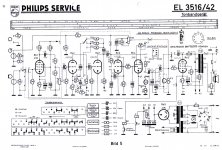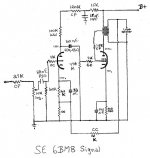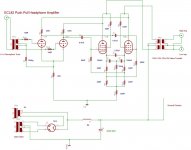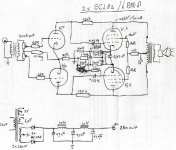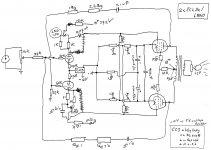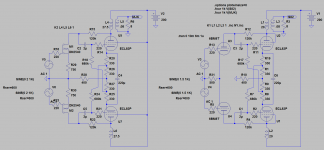How would the ECL86 be integrated into this circuit?
What would be the benefit over the ECL82?
As "Gimpy" pointed out, the triode in the 6GW8/ECL86 has more gain than the triode in the 6BM8/ECL82. The pentode is more powerful too. Unfortunately, the 6GW8 is quite scarce, while Russian 6BM8 equivalents are, at least for now, easily obtained.
If you are willing to deal with the heater supply issue, cost of NOS 16BM8/PCL82 stock should be favorable. The signal topology is (obviously) unchanged.
PCL86?
Quite a good deal of 10 PCL86 for 25 bucks (since you don't mind 13v heater)
http://www.ebay.com/itm/390325379770?ssPageName=STRK:MEWAX:IT&_trksid=p3984.m1438.l2649
What heater supply issue?
I am starting from scratch so I can build it however I need.
I have found some ECL86's on eBay for a reasonable (to me) price.
Quite a good deal of 10 PCL86 for 25 bucks (since you don't mind 13v heater)
http://www.ebay.com/itm/390325379770?ssPageName=STRK:MEWAX:IT&_trksid=p3984.m1438.l2649
Last edited:
Exxyyy is 6.3VAC heater/filament designed for parallel connection, current varies according to need.What is the difference between ECL & PCL?
Pxxyyy is 300mA heater/filament designed for series connection, voltage varies according to need.
Generally the cathode, grid and plate characteristics will be close or identical for like numbered valves.
Historically, P-series numbers were generally used in TVs without any mains transformer. There are also U-series numbers - 100mA heaters - again series connected. They were often used in radio applications in the same way. In this day and age, for new projects, a mains isolating transformer or some kind should always be used for safety.
(My first valve project, around 1978, used a UCL82 triode & pentode with a UY85 rectified to make a simple two valve mono-amplifier.)
If you are opening up the selection to the 6F3P, you might want to look at the 6F4P/6DX8/ECL84/PCL84 as well.
It was designed as a video amp, and as a result it is quite linear.
Furthermore, I have found that its plate dissipation rating (4W) is extremely conservative.
Running it at 8W dissipation is no problem and it does not red plate until you get to near 12 W.
Mu is low on the triode (65) in comparison to those with a mu of 100, but it is quite sufficient.
And as a bonus (in the USA or Canada), the 6DX8 version is on the dollar menu at ESRC.
http://www.esrcvacuumtubes.com/dollar_days.html
I've tried both the 6F4P and several 6DX8 variants and they were very consistent.
It was designed as a video amp, and as a result it is quite linear.
Furthermore, I have found that its plate dissipation rating (4W) is extremely conservative.
Running it at 8W dissipation is no problem and it does not red plate until you get to near 12 W.
Mu is low on the triode (65) in comparison to those with a mu of 100, but it is quite sufficient.
And as a bonus (in the USA or Canada), the 6DX8 version is on the dollar menu at ESRC.
http://www.esrcvacuumtubes.com/dollar_days.html
I've tried both the 6F4P and several 6DX8 variants and they were very consistent.
Last edited:
Consider this. It sounds excellent as a headphone amp, and should sound as good as a main amp. I have run my main system from this amp and it works OK but with woolly bass - but a change of output ratio would solve that.
Very cheap with the toroidal Outputs and cheap 15VA toroidals would substitute for the input as well. Should make the $200 target easily.
Includes a little Schade.
Shoog
Very cheap with the toroidal Outputs and cheap 15VA toroidals would substitute for the input as well. Should make the $200 target easily.
Includes a little Schade.
Shoog
Attachments
Shoog,
A little Schade? It is all Schade !
!
We have earlier agreed driver triodes and Schade do not mix that well. Examine your circuit as SE and you will find it will behave unacceptable with very high distortion long before clipping. When going PP, 2H is cancelled out, but high eneven harmonics will remain.
Try running it with a std jfet(2SK170?) below the triode as cascode and it will behave OK.
But removing the triodes alltogether and replacing them with depletion MOSFETs, MJK style, will make it work great! Will distort many times less.
This goes for Jaaps left one too.
A little Schade? It is all Schade
We have earlier agreed driver triodes and Schade do not mix that well. Examine your circuit as SE and you will find it will behave unacceptable with very high distortion long before clipping. When going PP, 2H is cancelled out, but high eneven harmonics will remain.
Try running it with a std jfet(2SK170?) below the triode as cascode and it will behave OK.
But removing the triodes alltogether and replacing them with depletion MOSFETs, MJK style, will make it work great! Will distort many times less.
This goes for Jaaps left one too.
Last edited:
Cheers,
In the application this was placed in it never goes above a fraction of a watt at which level it works extremely well. People who have heard it wanted to take it home - it works reasonably well up to a few watts to with any distortion softening the sound rather than hardening it. I would like to see the distortion predictions but have no way of measuring them.
Within its range - it is the best sounding amp I have built so far.
We are in total agreement that pentode drivers are the way to schade an amp. I used this amp as a proof of concept for the various design elements which subsequently went into my 807 tabor clone and my own 6080 DC7 amp - both of which used pentodes.
Shoog
In the application this was placed in it never goes above a fraction of a watt at which level it works extremely well. People who have heard it wanted to take it home - it works reasonably well up to a few watts to with any distortion softening the sound rather than hardening it. I would like to see the distortion predictions but have no way of measuring them.
Within its range - it is the best sounding amp I have built so far.
We are in total agreement that pentode drivers are the way to schade an amp. I used this amp as a proof of concept for the various design elements which subsequently went into my 807 tabor clone and my own 6080 DC7 amp - both of which used pentodes.
Shoog
Last edited:
Hey Shoog,
Note this is only indications.
Did two models, yours and a MJK-style. Removed the wacko input bias circuit as it made things even worse. The left one will give 8W, yours just above 4W before clipping. Had to do some guesswork as I didn´t know triode Ua.
Did the sims at 1W on both where MJK showed ballpark figures of 0,05%. Sounds small but MJKs prototype measures that type of figures too. Yours show close to 0,8%. Things can be bettered if separating the input cathode-resistors, then showing below 0,4%.
Please check schematic to see if I made any gross errors.
Note this is only indications.
Did two models, yours and a MJK-style. Removed the wacko input bias circuit as it made things even worse. The left one will give 8W, yours just above 4W before clipping. Had to do some guesswork as I didn´t know triode Ua.
Did the sims at 1W on both where MJK showed ballpark figures of 0,05%. Sounds small but MJKs prototype measures that type of figures too. Yours show close to 0,8%. Things can be bettered if separating the input cathode-resistors, then showing below 0,4%.
Please check schematic to see if I made any gross errors.
Attachments
Hey Shoog,
Note this is only indications.
Did two models, yours and a MJK-style. Removed the wacko input bias circuit as it made things even worse. The left one will give 8W, yours just above 4W before clipping. Had to do some guesswork as I didn´t know triode Ua.
Did the sims at 1W on both where MJK showed ballpark figures of 0,05%. Sounds small but MJKs prototype measures that type of figures too. Yours show close to 0,8%. Things can be bettered if separating the input cathode-resistors, then showing below 0,4%.
Please check schematic to see if I made any gross errors.
If you don't use the triode of the ECL82 it is perhaps a better idea to use a EL84 in the left design ?
Thanks for the analysis.
I have to say - in its designed purpose it is a beautiful little amp which really sings - even with the funky input bias (in fact I would say at least partly because of it).
Not efficient, not best measurements and probably not a good candidate for a power amp in its current form - but its a keeper for me as a loafing headphone amp.
Shoog
I have to say - in its designed purpose it is a beautiful little amp which really sings - even with the funky input bias (in fact I would say at least partly because of it).
Not efficient, not best measurements and probably not a good candidate for a power amp in its current form - but its a keeper for me as a loafing headphone amp.
Shoog
- Status
- This old topic is closed. If you want to reopen this topic, contact a moderator using the "Report Post" button.
- Home
- Amplifiers
- Tubes / Valves
- ECL82 Single Tube Amp
